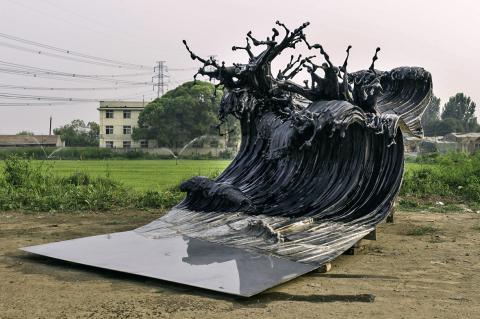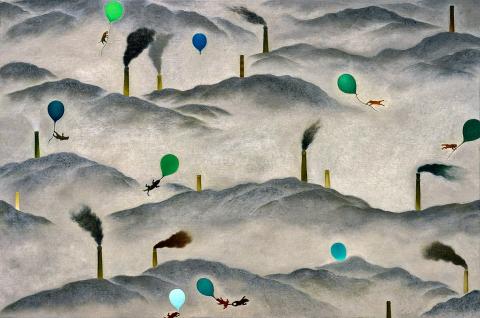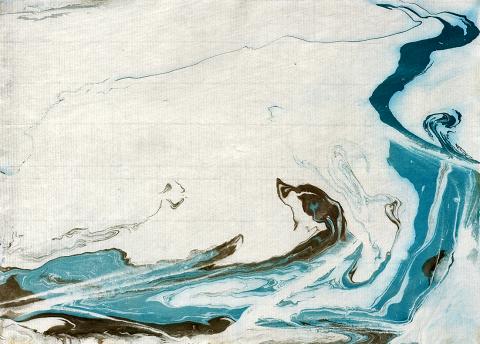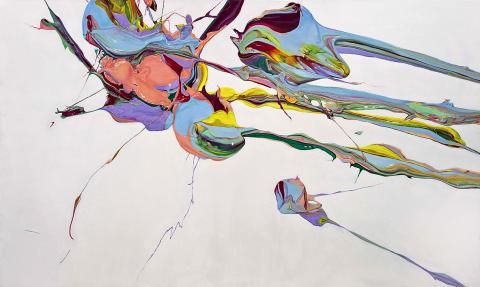Nature is Huang Kai-hsing’s (黃楷馨) muse, particularly the subtle elements such as the curvature of a water droplet resting on a leaf, or the pattern that a flower petal makes when a gust of wind lifts it up in the air. It’s not so much that Huang doesn’t care about the bigger picture; it’s more the case that she believes in relishing what we have at the present moment. Her paintings have a pastoral aura and they appeal to senses other than sight — it’s almost as if we can hear the leaves ruffling in the breeze or taste the gushing stream. Thoughtful and lyrical, Huang’s work has a feeling of being freshly minted and timeless at the same time. A collection of her work can be viewed at Taipei’s In River Gallery in an exhibition entitled Between Grasp and Release (雲渡風行).
■ In River Gallery (穎川畫廊), 2F, 45, Renai Rd Sec 1, Taipei City (台北市仁愛路一段45號2樓), tel: (02) 2357-9900. Open Tuesdays to Sundays from 1pm to 8pm
■ Until Nov. 25

Photo courtesy of MOCA Taipei
Light and sound seem to be popular choices these days for artists who eschew traditional mediums. Bluerider Art’s latest exhibition, Daydream, features light and sound installations by Nonotak Studio, which is a collaboration between illustrator Noemi Schipfer and architect-musician Takami Nakamoto. The duo creates an alternative universe with their hypnotizing videos which fill the entire gallery. Three-dimensional spirals, zigzags and squares twist, turn and jiggle in a neon-lit room as a sound system blasts futuristic beats. The idea is to transport us to a disoriented, dream-like state where we feel like we’re hallucinating and thinking happy thoughts. It’s cool, high-tech stuff, but what’s the difference than going to a night club?
■ Bluerider Art (藍騎士藝術空間), 9F, 25-1, Renai Rd Sec 4, Taipei City (台北市仁愛路四段25-1號9樓), tel: (02) 2752-2238. Open Tuesdays to Saturdays from 9am to 6pm
■ Until Dec. 26

Photo courtesy of Taipei Fine Arts Museum
Lu Zheng-yuan (盧征遠), who hails from China’s Liaoning Province, is one of those artists who rebels against having a definitive style. While some of his paintings are realistic (a vase filled with flowers), others are wholly abstract (colorful paint splashed across a blank canvas). But even his realistic paintings are a little puzzling. Although Lu depicts everyday objects, there is always something in the frame that’s out of place — for instance, a wine glass sitting in the middle of a pile of fruit. He does this to distort the viewer’s idea of what to expect, very much like how an author might toy with linearity in narrative. Lu’s paintings — and some of his sculptures — are currently on display at Taipei’s Museum of Contemporary Art in the aptly named exhibition Oxymoron (替身).
Calligrapher-turned-sculptor Zheng Lu (鄭路), born and bred in Inner Mongolia, also has a riveting exhibition at MOCA. Zheng was trained in traditional Chinese calligraphy as a child, and it wasn’t until graduate school that he started experimenting with three-dimensional forms. The exhibition is named Shiosai (潮騷) after a romance novel about a young fisherman and the daughter of a fishing boat owner written by Japanese author Yukio Mishima. The novel served as inspiration for Zheng’s stainless steel sculptures which challenge preconceived notions of sculptures being solid. Although Zheng uses sturdy material, his sculptures — all of which allude to water — have a gentle and flowing feel. For instance, waves are suspended in mid-air and droplets look like they might trickle down onto the viewer. An appropriate exhibition for anyone who loves the ocean or anyone who loves optical illusions.
■ Museum of Contemporary Art, Taipei (台北當代藝術館, MOCA), 39 Changan W Rd, Taipei City (台北市長安西路39號), tel: (02) 2552-3720. Open Tuesdays to Sundays from 10am to 6pm

Photo courtesy of In River Gallery
■ Both exhibitions run until Jan. 3 and admission is NT$50
Animals evoke in us a wide range of emotions. While some are fuzzy and adorable, others can be repulsive or threatening. Su Wong-shen (蘇旺伸) takes a different approach in his paintings of animals. From afar, his paintings appear to resemble wallpaper with farm animal motifs — in other words, something that you would hang on the walls of your child’s bedroom — but upon closer examination, it’s evident that the cute animals are actually caught in bizarre situations such as being flung from a moving ferris wheel or holding onto balloons circling around smoke stacks. Moved by the dire situation of stray animals in Taiwan, Su initially set out to incorporate their plight in his artwork. Since then, animals have been his muse. His latest exhibition, Animal Farm: The Paintings of Su Wong-shen (動物莊園:蘇旺伸四十年繪畫展), is held at the Taipei Fine Arts Museum and features a vast collection of his paintings spanning a period of four decades. The title might be an allusion to George Owell’s 1945 novel, but there are some differences. While the animals in Owell’s novel were the perpetrators, the ones in Su’s paintings are victims of abuse at the hands of human beings.
■ Taipei Fine Arts Museum (台北市立美術館 TFAM), 181, Zhongshan N Rd Sec 3, Taipei (台北市中山北路三段181號), tel: (02) 2595-7656. Open Tuesdays to Sundays from 9:30am to 5:30pm and until 8:30pm on Saturdays

Photo courtesy of MOCA Taipei
■ Until Feb. 14

April 14 to April 20 In March 1947, Sising Katadrepan urged the government to drop the “high mountain people” (高山族) designation for Indigenous Taiwanese and refer to them as “Taiwan people” (台灣族). He considered the term derogatory, arguing that it made them sound like animals. The Taiwan Provincial Government agreed to stop using the term, stating that Indigenous Taiwanese suffered all sorts of discrimination and oppression under the Japanese and were forced to live in the mountains as outsiders to society. Now, under the new regime, they would be seen as equals, thus they should be henceforth

Last week, the the National Immigration Agency (NIA) told the legislature that more than 10,000 naturalized Taiwanese citizens from the People’s Republic of China (PRC) risked having their citizenship revoked if they failed to provide proof that they had renounced their Chinese household registration within the next three months. Renunciation is required under the Act Governing Relations Between the People of the Taiwan Area and the Mainland Area (臺灣地區與大陸地區人民關係條例), as amended in 2004, though it was only a legal requirement after 2000. Prior to that, it had been only an administrative requirement since the Nationality Act (國籍法) was established in

With over 80 works on display, this is Louise Bourgeois’ first solo show in Taiwan. Visitors are invited to traverse her world of love and hate, vengeance and acceptance, trauma and reconciliation. Dominating the entrance, the nine-foot-tall Crouching Spider (2003) greets visitors. The creature looms behind the glass facade, symbolic protector and gatekeeper to the intimate journey ahead. Bourgeois, best known for her giant spider sculptures, is one of the most influential artist of the twentieth century. Blending vulnerability and defiance through themes of sexuality, trauma and identity, her work reshaped the landscape of contemporary art with fearless honesty. “People are influenced by

The remains of this Japanese-era trail designed to protect the camphor industry make for a scenic day-hike, a fascinating overnight hike or a challenging multi-day adventure Maolin District (茂林) in Kaohsiung is well known for beautiful roadside scenery, waterfalls, the annual butterfly migration and indigenous culture. A lesser known but worthwhile destination here lies along the very top of the valley: the Liugui Security Path (六龜警備道). This relic of the Japanese era once isolated the Maolin valley from the outside world but now serves to draw tourists in. The path originally ran for about 50km, but not all of this trail is still easily walkable. The nicest section for a simple day hike is the heavily trafficked southern section above Maolin and Wanshan (萬山) villages. Remains of